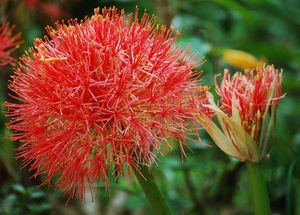One of the things that northern gardeners miss the most when gardening in South Florida is spring flowering bulbs. Unfortunately, without some serious special preparation, spring flowering bulbs such as daffodils and tulips won’t grow here. Nevertheless, the big box stores carry them every year. That seems like deceptive sales practices to me. Someone has to know that these things don’t grow here, and that people will buy them thinking they will, and then be disappointed. It’s just a gimmick to get a buck out of gullible snowbirds who don’t know any better.
Although these bulbs won’t grow in South Florida, there are many beautiful flowering bulbs that are great for South Florida gardening. In the Amaryllis family alone, there are 6 different species of bulbs that I find will thrive in my garden. Within these species, there are hundreds of natural and hybridized varieties to suit anyone’s taste.
Amaryllis (Hymenocallis spp.)
If you really want some pretty spring blooms, plant some of the early blooming amaryllis bulbs. Hybrid amaryllis flowers come in all shapes, sizes, and colors, and are easy to grow in South Florida. Several members of the Hymenocallis family are native to Florida, and can be seen growing on boggy roadsides. The native “Alligator lily” , Hymenocallis palmeri, is one of the most common, but other Hymenocallis species are found in Florida, as well as other southern states.
Crinum Lily (Crinum spp.)
Crinums come in two sizes, regular and giant. Regular crinum lily blooms are borne on stalks about 18-24 inches high. They have multiple flowers, which bloom sequentially, from bottom to top, so each bloom stalk will keep blooming for sometimes several weeks. They only come in two colors: pink, white, or variations of the two. Giant crinums are spectacular when they bloom, with their spider-like flowers. One of their common names is giant spider lilies, which is a misnomer, since the native Florida giant spider lilies are related to the lycoris, not crinums. Giant crinums also come in variations of pink and white. Crinum lilies grow in clumps that are ever expanding, so it’s good to give them some room to grow when you plant them.
The above two are the most common bulbs for South Florida gardening, there are 4 other Amaryllis bulb species that are just as beautiful, and just as desirable.
Florida Spider Lily (Lycoris latifolia)
Also a member of the Amaryllis family, these lilies are large and showy. They thrive in moist, well drained soil. During long periods of drought, this lily’s bulbs may dry up and disappear. The bulbs multiply rapidly, and even though they can be grown from the seed, it may take many years before they will mature and bloom.
Blood Lily (Haemanthus multiflorus)
There are not many flowers are spectacular and showy as a Blood Lily. It’s large globe shaped red flowers are striking enough to garner questions from anyone passing by. In the South Florida garden, they like to be kept fairly dry, and don’t like fertilizer.
Nerine Lily (Nerine spp.)
These adorable small blooming bulbs are best grown in pots, and bloom best during the rainy season, going dormant during the dry season. Still, you must be careful not to let them dry out completely during dormancy, or they will not come back the next year.
And what kind of South Florida gardening fanatic would have a garden without this next bulb, a perennial favorite.
Rain Lily (Zephyranthes spp.)
Rain lilies pop up when it rains, and multiply so easily from bulbs and seed, that South Florida gardeners give away bags full of them. They are usually pink (Z. grandiflora) or white (Z. candida), but Zephyranthes citrina is a beautiful golden yellow. They are wonderful for naturalizing, and will bloom in sun or shade.
South Florida gardening is nothing like gardening up north, but you don’t have to give up flowering bulbs. The Amaryllis family holds only a few of the many bulbs that thrive in our subtropical climate.
References:
University of Florida IFAS Extension: Bulbs for Florida
Plantz Africa: Crinum L.
The Palm Beach Post: Spider Lily
Pacific Bulb Society: Hymenocallis
Reference:
- voices.yahoo.com/direct-composting-saves-garden-space-10369887.html?cat=32
- voices.yahoo.com/southern-gardening-natural-controls-powdery-mildew-3157260.html?cat=
- voices.yahoo.com/gardening-south-florida-summer-vegetables-2818569.html?cat=32
